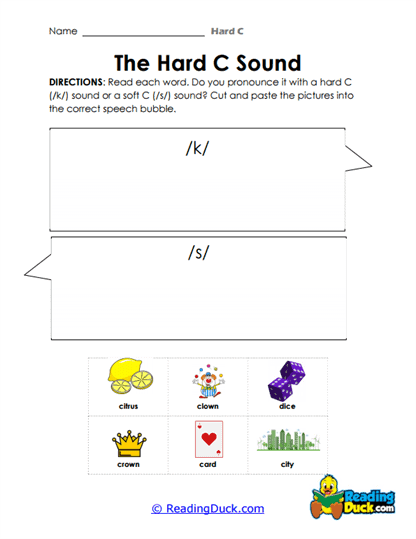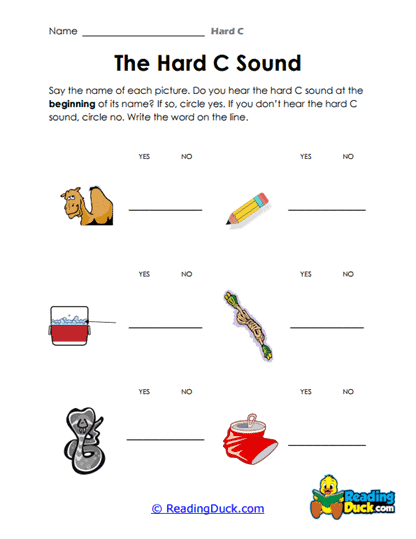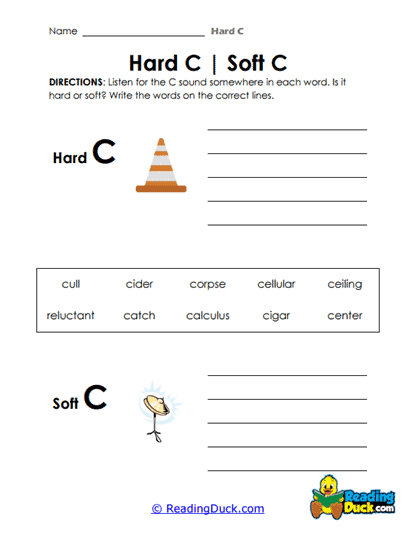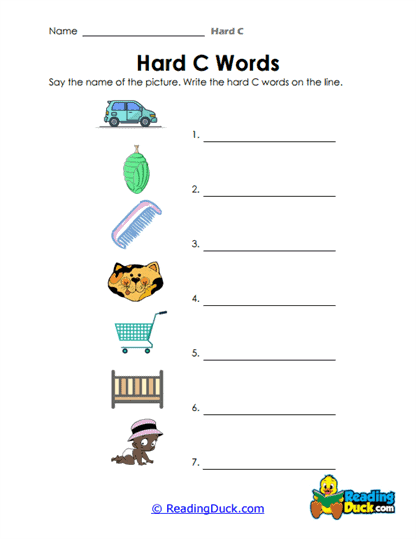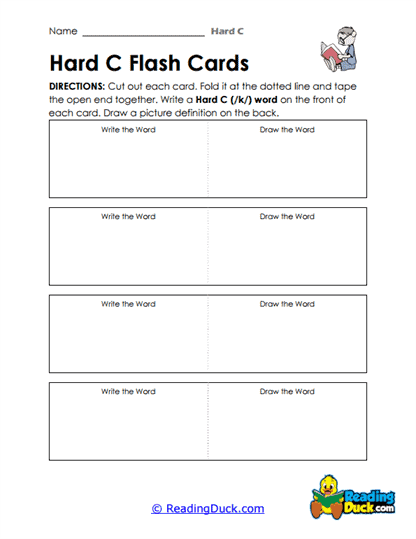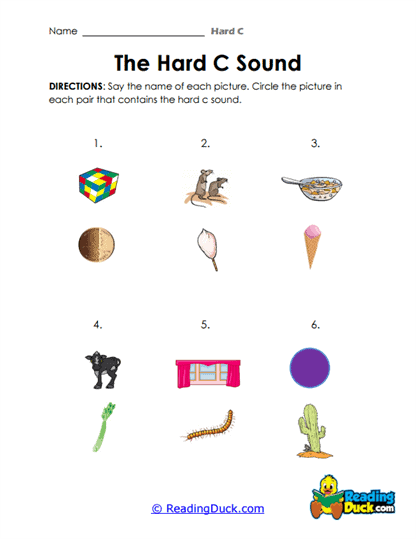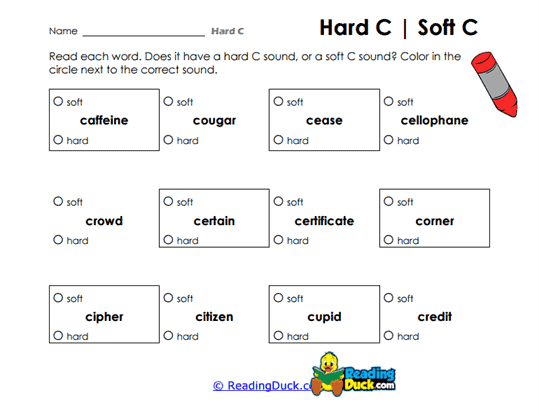Hard C Worksheets
About Our Hard C Worksheets
Our collection of Hard C Worksheets is a valuable resource in the 'Phonics' category within the 'Pre-Reading' section, specifically designed to help young learners understand and master the sound of the hard "C." These worksheets focus on teaching students how to recognize, pronounce, and spell words that start or contain the hard "C" sound, an essential component of early literacy.
Available in PDF format, these worksheets are easy to view, download, and print, making them ideal for use in both classroom and homeschool settings. Each worksheet is accompanied by a downloadable answer key, allowing educators and parents to guide students effectively through their learning process while also simplifying assessment.
Understanding the Hard C Sound and Its Importance in Early Reading Development
The hard "C" sound is a foundational element of phonics, playing a critical role in early reading and spelling development. As a professional licensed teacher specializing in pre-reading skills, it’s important to dive deeply into what the hard "C" sound is, why it is important, and how it influences a child's literacy journey.
What Is the Hard C Sound?
- Definition: The hard "C" sound is the /k/ sound that occurs when the letter "C" is followed by the vowels "a," "o," or "u," or when it appears before a consonant. Common examples include "cat," "corn," and "cup."
- Contrast with Soft C: Unlike the soft "C" (which sounds like /s/ in words like "city" or "cent"), the hard "C" produces a strong /k/ sound. Understanding this distinction is crucial for developing accurate pronunciation and spelling skills.
The Role of the Hard C Sound in Literacy:
- Phonemic Awareness: Mastering the hard "C" sound is integral to developing phonemic awareness—the ability to identify and manipulate sounds in words. This skill is a foundational aspect of learning to read.
- Decoding Skills: Recognizing the hard "C" sound aids in decoding words, helping children sound out unfamiliar words more effectively. This is a key step in becoming a fluent reader.
- Spelling Accuracy: Understanding when and why "C" makes the /k/ sound helps students spell words correctly, especially those that could be confused with soft "C" sounds or with "K" sounds in spelling.
- Word Recognition: Familiarity with the hard "C" sound enhances a child's ability to recognize and read a broader range of words. This skill is essential for building a strong vocabulary and improving reading comprehension.
Examples of the Hard C Sound in Context:
- "Cake": In the word "cake," the "C" at the beginning produces the hard /k/ sound, which is straightforward for young learners to grasp. Recognizing this pattern helps them decode and spell similar words like "car" and "coat."
- "Clock": The word "clock" contains the hard "C" sound at both the beginning and the end, reinforcing the concept and helping students apply the sound in different positions within a word.
How These Worksheets Support the Learning and Practice of the Hard C Sound
Our Hard C Worksheets are carefully designed to assist young learners in recognizing, understanding, and practicing the hard "C" sound in a variety of contexts. These worksheets play a crucial role in building students' phonics skills and overall literacy development.
Focused Phonics Instruction:
- Targeted Sound Practice: The worksheets are structured to emphasize the hard "C" sound, helping students focus on this specific phonics element. This targeted practice ensures that learners develop a strong grasp of the sound and how it is used in different words.
- Reinforcement of Phonics Rules: By consistently practicing words that contain the hard "C" sound, students reinforce their understanding of when and why "C" sounds like /k/. This reinforcement is critical for ensuring that students can apply this knowledge independently.
- Building Decoding Skills: The worksheets provide ample opportunities for students to decode words that contain the hard "C" sound, enhancing their ability to sound out new words confidently. This is essential for developing reading fluency and accuracy.
Supporting Independent Learning:
- Self-Paced Learning: The worksheets are designed for independent use, allowing students to work through them at their own pace. This flexibility is especially valuable in both classroom and homeschool environments, where students may be at different levels of phonics proficiency.
- Visual and Auditory Reinforcement: The worksheets include visual aids, such as pictures of objects that begin with the hard "C" sound, to help students make connections between the sound and the letter. Auditory reinforcement, such as saying the words aloud, helps solidify the learning experience.
Strategies for Teaching the Hard C Sound Effectively
Teaching the hard "C" sound requires a thoughtful approach to ensure that young learners understand the concept and can apply it confidently in their reading and writing. Here are some strategies that educators can use to introduce and teach the hard "C" sound effectively:
Introducing the Hard C Sound:
- Begin with Simple Words: Start by introducing the hard "C" sound using simple, familiar words such as "cat," "cup," and "car." These words provide a clear and accessible example of the sound in context.
- Use Visual Aids: Incorporate visual aids like flashcards, word charts, or digital tools that highlight the hard "C" sound in different words. Visuals help students associate the /k/ sound with the letter "C" and recognize it in various contexts.
- Modeling and Guided Practice: Demonstrate how to pronounce the hard "C" sound by breaking down words into their individual sounds. For example, say "cat" slowly, emphasizing the /k/ sound at the beginning. Guided practice with the class or in small groups helps reinforce the concept.
Helping Students Master the Hard C Sound:
- Interactive Reading: Include books or passages that contain words with the hard "C" sound in your reading sessions. Pause to highlight these words and discuss the sound with students, reinforcing their understanding in a real-world context.
- Repetitive Practice: Ensure that students have plenty of opportunities to practice reading and spelling words with the hard "C" sound. Repetition is key to mastery, so integrate these words into daily phonics lessons and reading activities.
- Word Exploration: Encourage students to find and share examples of words with the hard "C" sound in their reading materials. This exploration not only reinforces their understanding but also builds their confidence in applying phonics rules independently.
Practical Tips for Using Hard C Worksheets Effectively
To make the most of the Hard C Worksheets, educators and parents can employ the following practical tips to ensure that young learners thoroughly understand the concept and can apply it confidently.
Integrating Worksheets into Daily Practice:
- Morning Warm-Ups: Use the worksheets as part of a morning warm-up routine. This helps students start the day with a focus on phonics, reinforcing the hard "C" sound in preparation for the day's learning activities.
- Homework Assignments: Assign worksheets as homework to provide additional practice. Encourage parents to review the hard "C" sound with their children, reinforcing what was taught in class and offering support where needed.
- Small Group Instruction: Utilize the worksheets during small group instruction for targeted phonics practice. This allows for personalized guidance and the opportunity to address any challenges students might face with the hard "C" sound.
Supplementary Activities to Reinforce Learning:
- Sound Sorting: Create a sound-sorting activity where students categorize words based on whether they start with a hard "C" sound or another consonant sound. This activity helps students see the differences between various beginning sounds and reinforces their understanding of the hard "C."
- Interactive Phonics Games: Incorporate phonics games that focus on the hard "C" sound, such as bingo or matching games. These activities make learning engaging and fun while providing additional practice with the concept.
- Creative Writing: Encourage students to write sentences or short stories using words with the hard "C" sound. This activity not only reinforces the phonics pattern but also enhances their writing skills and creativity.
Building Confidence and Phonics Skills with Hard C Worksheets
In summary, our Hard C Worksheets within the 'Phonics' category of the 'Pre-Reading' section are a crucial tool for helping young learners develop a solid foundation in phonics, particularly in recognizing and applying the hard "C" sound. By focusing on this specific phonetic element, these worksheets empower students to build their reading and spelling skills, laying the groundwork for more advanced literacy development.
The impact of mastering the hard "C" sound goes beyond just phonics; it builds confidence in young readers as they become more adept at decoding and spelling words correctly. As they practice and apply this sound in various contexts, students gain the assurance they need to tackle more complex words and texts.
Educators and parents can use these worksheets to create an engaging and supportive learning environment that fosters both independent practice and guided instruction. With consistent use, supplemented by interactive activities and real-world applications, students will not only master the hard "C" sound but also develop a love for reading and learning that will carry them through their educational journey.
These worksheets are particularly well-suited for kindergarten through second-grade learners and are an indispensable part of any early literacy curriculum. They ensure that young readers acquire the phonics skills and self-assurance they need to excel in their reading and writing endeavors, paving the way for future academic success.
